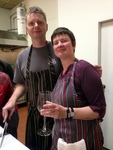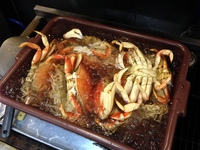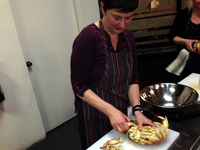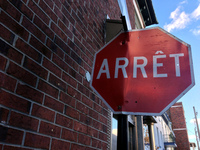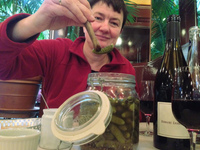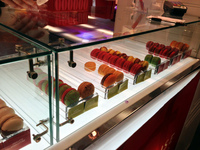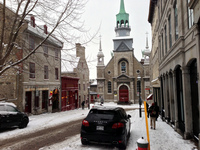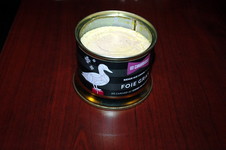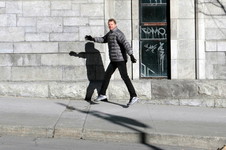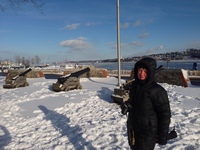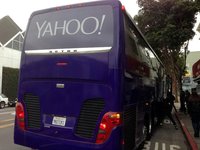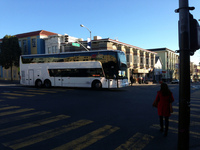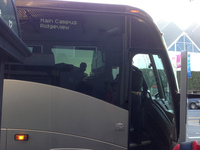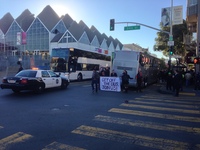 |
| Angelika/Mike Schilli |
|
|
Angelika It's really not easy to find a present for Michael, as he has the bad habit of buying everything himself, especially as short a week before his birthday or Christmas.
He's reading books, but exclusively as e-books, and instead of listening to CDs, he prefers streaming services like "Spotify" or "Rhapsody". That makes finding presents for him extremely difficult, and I've been surprising him with joint adventures instead.
Because Michael likes to cook and I once enjoyed taking cooking classes a long long time ago, my gift to him this year was a cooking class for the both of us. After researching quite a bit, I found "Jordan's Kitchen" just around the corner from us in the Mission neighborhood. Jordan, a famous chef, offers four hour classes teaching how to prepare a four course meal. Since Michael and I love "Dungeness Crab", and we've always wanted to know how to cook them starting from scratch, so I signed up for the "Crab Cookout".
Dungeness Crab are native to the San Francisco Bay and the Pacific Ocean close to the U.S. west coast, harvesting season is typically between November and June. They are truly gargantuan in size, the massive body harness measures between six and eight inches in diameter and the whole crab weighs about 2 pounds. Our cooking class happened at the end of January, there were fourteen students and chef Jordan told us everything there is to know about cooking crab. We had such a great time! At first I had some doubts whether I would dare to grab a living crab and place it in boiling water, but we learned that you need to snatch the crab from behind so that it can't get your fingers with its claws and bravely I gave in to group pressure.
Interestingly enough, the clawed creatures first seemed quite apathic, but started fidgeting as soon as we picked them up. When quickly submerged in boiling water, they stopped immediately, thankfully. We were sipping some wine during the class, and the participants were all pretty relaxed. Jordan also demonstrated how to take out the inedible parts of the cooked crab. We removed the upper plate, and took out intestines like the lungs. There's some meat in the crab body as well, which can be pulled out after cutting the carcass in quarters, but the main source are the crab's claws and its eight feet, and getting to the delicious meat inside requires cracking their hard outer shells first.
Here's the list of the four courses we cooked: Dungeness crab meat in coconut milk on cucumber slices; Bucatini pasta with crab meat; roasted crab in orange and garlic butter; apple and pear compote with cornflower croutons. What was nice was that all participants cooked and later ate as one big team. And I received a personal training from Jordan on how to use a chef's knife! Highly recommended class!
Michael In December this year, we traveled to Canada. This time, we set out to explore the French-speaking part on the east coast and first had a stop-over after a five hour flight in Toronto. According to several previous experiences, Canadian immigration personnel are about the unfriendliest people on earth, and living up to our expectations, the person behind the counter greeted us this time by balking "What do you want in Canada?!" at us. Luckily, we know how to deal with this kind of situation. But, really, Canada?
When we asked our cab driver on the way from the airport to downtown Montreal if he spoke English, and we of course asked in French, he laughingly exclaimed: "No!" and we set out to explain that we only spoke very little French. The rest of the ride resumed in silence. I still remembered French numbers from school way back when pretty well, so I could at least tell him how much I was willing to pay for the ride including tip as we safely arrived.
We were truly shocked that except for a few American tourists everyone speaks French in Montreal. Every store you enter, the first thing you hear is "Bonjour!" and if you don't clue people in, they start throwing French at you at a speed that is really hard to understand for non-native speakers. For what it's worth, I have spent a solid five years of my life learning French, in a high school in Germany from 7th to 11th grade, four hours a week. Admittedly, French in school never resonated with me and I ended up with barely passing grades, but this illustrates fairly well that there's certain areas where the German education system went right by me without much effect.
But if the visitor then carefully inquires if their vis-à-vis might perhaps speak English ("Parlez-vous Anglais?"), it turns out that every native under 30 does so fluently. We found out that apparently French-Canadians get upset when visitors automatically assume that everyone speaks English. It seems a bit strange, but, hey, when in Rome.
Another oddity are the store opening hours, which are rather European than American. For example, we went to this grocery store right by the train station, and knowing they might be closing early on a Saturday, we inquired about how long they were open, and learned while gnashing our teeth that they would close at 5pm. To make sure we still would be able to get our groceries for the weekend, we showed up at 4:15pm and saw to our surprise that the meat counter was virtually sold out and the cheese fridge had already been covered up with protective tarp. Luckily, we had been there the day before, knew where everything was located, and were able to direct a sales person to the sealed-off areas in order to get a few items for our evening meal.
In one store, we inquired if there was a bakery nearby. All the clerks stuck their heads together, and started a lively discussion in French. After some back and forth, from what we understood there were several shopping malls that were evaluated, they concluded that it was too complicated to explain, and no, they were sorry, but they couldn't tell us where the next bakery was. Wha-what? We found this quite strange, because, I mean, if someone asked us in downtown San Francisco where the next bakery was, most likely we'd be scratching our heads a bit because high rents typically drive bakeries to the outskirts, but we would certainly be able to give directions on how to get to the nearest location.
And having lived for decades in the United States, we noticed a few stunning small differences in the French part of Canada: Sales clerks handling food aren't wearing gloves like back in the States. When we dined at a really good French bistro in Montreal one day, the waiter placed a gigantic jar with pickles on our table, and we extracted as many gherkins as we liked by using a pair of big wooden tongs provided for this purpose. When we were done, the waiter took the jar away, only to set it down at a different party's table! This would never fly in the U.S., the health department would start issuing violations and patrons would freak out! As born Europeans, we liked it, of course.
In the excellent "Beaver Hall" restaurant, named after the street it is located on, the waiter placed a whole loaf of bread on our table after we ordered, and put a gigantic bread knife with a serrated blade next to it. Imagine that to happen in the U.S., the restaurant owner would certainly worry about clumsy or reckless guests injuring themselves and having to deal with the resulting liability issues and million-dollar lawsuits!
Across the board, dining in the French part of Canada is a truly eye-opening experience, the food was truly excellent whereever we went. It's not exactly cheap but well worth the money, and the patrons are dressed up much fancier than in the U.S., although you can only tell after they've taken off their puffball-sized down jackets, which the waiters quickly put away to place them in the coat check area.
Another French specialty are the so-called "Macrons". Those two-layered cookies feature fillings of all kinds of flavors, and they're packed into small cardboard boxes by the dozen. Allegedly, they're really complicated to make, which is why, so the rumor goes, one cookie the size of a postage stamp costs more than a dollar. They're not bad, but I'd hardly drive all the way up to Canada to taste them. The sales person packs exactly one dozen into a small rectangular box, and if they don't fit all in, they're being squeezed until they do.
After three cold, but sunny days (always around 32F), all of a sudden, one morning, there were four inches of snow on the ground. We had done our homework and brought our Alaska gear to Montreal, so we just bundled up and grudgingly trudged through the slushy snow on the sidewalks. Interestingly, traffic was largely unimpacted.
When it comes to retailing alcoholic beverages, Canada features some of the most absurd regulations known to man. Details vary from state to state, so for example in the city of Montreal, located in the state of Quebec, supermarkets are legally allowed to sell wine and beer, but no hard liquor. A government-controlled store chain named "SAQ" (Société des alcools du Québec), on the other hand, offers wine, beer, and hard liquor in a somewhat elevated price category. Their store hours aren't exactly customer friendly, though, for example, they're closing at 5pm on Sundays!
Restaurants often have a liquor license, but many don't, and by displaying a "Apportez votre vin" sign, they're inviting customers to bring their own wine, usually purchased from a nearby store. Unlike in the U.S., they usually don't charge a "corking fee". It's a very good deal, as wines that cost $10 retail a bottle are often listed for $50 on the wine menu.
As you might know, selling foie gras in California has been outlawed about a year ago (Rundbrief 11/2012). Other states, for example Nevada, still offer it, and, as you've probably guessed, it's a staple on the menus in many French Canadian restaurants. Whenever the government takes something away, the natural reaction is to crave it, and when we saw that $25 can of foie gras on a christmas market in Montreal, we had to get it. Applied as spread on cruncy European-style bread sold at the "Premier Moisson" bakerey which, against all odds, we managed to find anyway, it tasted fabulous.
As soon as we got off the train in Quebec, we noticed that the outside temperature had gone down from "frosty" to "brutally cold". During our stay, we experienced cold snaps with temperatures as low as -14F (-26C), and if you're outside on such a day and the cold wind is blowing in your face, this gets old pretty quickly.
Quebec is an astonishingly old city, at least it seems so when you're visiting from the United States. Its history dates back to the 17th century, and its old town at the top of the hill is called "Haute-Ville", connected to the lower part "Basse-Ville" by both an ancient elevator and a regular road.
There's many ancient cannons standing around everywhere throughout the city and all kinds of old masonry for the curious visitor to inspect. From what we've heard, during the summer months, Quebec turns into a possibly hard to bear tourist location, with all kinds of buzzling festivals and packed stores and restaurants. During the winter months, however, it is charminging bleary, and the few restaurants still open bid a warm welcome to visitors, and will happily walk them through the entire menu in English if that is what it takes.
It's a photographer's paradise. The sun usually hangs low on the horizon, casting an almost horizontal light, which creates a grandiose ambience. The air is crystal clear, due to the extreme cold, and the only hard part is hitting the release without taking off the mittens! Hitting the button on a pedestrian crossing light while wearing mittens poses the same problem, but Quebec solved this one by placing sensors next to the buttons and all you need to do to trigger the signal is to hold your mitten next to it (Figure 24).
We found Canada's French-speaking part way more interesting than its western parts, which are mainly a pretty lame version of similar American cities. Vancouver or Toronto are not more than a poor man's San Francisco, and can be safely skipped, but travelers exploring Canada's east side will find a truly unique culture. We got a refresher in speaking French and ate a lot of excellent food. In Montreal, for example, I had a Filet Mignon so undescribably tender that I can't name a place which serves anything even remotely comparable. Beware, though, that French Canadians use a lot of butter in their cuisine, which can make you feel a bit bloated after a while. People are very friendly there, just don't forget to always start a conversation in French, even if it's just asking for a table for two in a restaurant. After the initial ice breaker, you can safely switch to English.
If you want to see more of our photos taken in Montreal and Quebec, check out our Flickr Album dedicated to this memorable vacation.
Michael In the beginning, there was only the Google bus. Dating back to 2008 (Rundbrief 05/2008), the Internet giant has been picking up employees all over San Francisco and is driving them down to Silicon Valley every day. And even back then, upset neighbors complained about the dark heavy luxury buses, roaming through small residential streets in the early morning hours, some of them letting their engines idle for ten minutes while waiting. The gossip site Allthingsd ran the story "San Francisco May Crack Down on Corporate Shuttle Buses" and even rumored that San Francisco might soon be imposing new regulation for the tech buses.
Nowadays, every big Silicon Valley company offers shuttles as a perk, because they're all aware that tech workers who are forced to commute during rush hour between 7:30 and 9:00 in the morning on the chronically clogged freeways 101 and 280, will sooner or later either go bananas or look for different employment opportunities directly in the city. Today, I'll let you in on which company is running which bus, as most of them are unmarked and only employees know their shuttles and where they're headed. Actually, on sfist.com someone went through the exercise of following the shuttles on their routes through the city and put the findings on a map.
The shuttles also offer cargo areas in their lower parts, accessible via the side hatches, allowing for luggage to be stored and brought along on the ride. Some hipsters live quite far from the shuttle stop, ride their bikes there and then store them in the shuttle's belly when it arrives. On the bus, the passengers enjoy free Wifi to hook up with the company network during the ride, to check email or get work done, just as if they were sitting at their desks at work.
Each shuttle-operating Silicon Valley company covers different neighborhoods. Google offers the best coverage with an astounding 22 unmarked stops across town (Figure 29), provided by a half-dozen different bus routes. As soon as they reach the city limit, they proceed non-stop to Google's headquarters in Mountain View.
Most of the company shuttles pick up employees at otherwise rarely used public transit stops, frequented otherwise by San Francisco's MUNI bus system. Occasionally, this gets people confused, because if there's ten people waiting in line, it happens that regular folks or sometimes even homeless people join in, only to realize later that those young computer nerds (easily to recognize by shouldered backpacks and smart phone in hand) then start boarding an unmarked private shuttle with destination unknown.
Every once in a while, a confused Googler lines up at the Yahoo stop, which is when they're politely directed to their stop around the corner. Employees can be told apart by watching for tiny details: Yahoos are often carrying backpacks of the "Targus" brand, with a small "Y!" label on it, and many of them are wearing "Flickr" t-shirts. Googlers carry their laptops in unmarked backpacks of the "Swiss Army" brand. Google t-shirts seem to have gone out of fashion, hardly anyone is wearing them anymore. The shuttles themselves conceal their identiy as well, except for the purple Yahoo bus which sports a big "Yahoo" banner on its back. All others can be distinguished only by looking very closely for small marks, only known to insiders.
Here's a few insider tips: The Google shuttle is usually a black double decker bus with tinted windows, displaying "GBUS MTV" on an LED screen in one of the lower side windows to indicate that it's destined to Google Headquarters in Mountain View, at the "Shoreline Boulevard" exit. Facebook is running a big single decker bus, coyly displaying "MPK" on the side top to hint on the fact that it goes to the Facebook campus in Menlo Park. The Apple shuttle displays "Main Campus Ridgeview", and Apple employees know that the bus will stop at the main Apple campus in Cupertino, as well as the smaller campus at Ridgeview Court.
It's not very common that riders talk to each other at the stop, if you're working for a company with more than 10,000 employees, that's like a small city, and you wouldn't strike up a conversation with random people either. Until recently, one of the Yahoo stops was located right across the street from a gathering point for South American esquineros (day laborers, see Rundbrief 05/2009), who are dressed up in hoodies and waiting for the next pickup truck to take them to a nearby construction site to make a few dollars off the record. They must have wondered what was going on across the street, where a line of backback-wearing hipsters kept growing by a person a minute, each of them silently typing away on their smartphones.
Recently, a few upset hooligans even blocked a fully occupied Google bus and prevented it from leaving the stop. The protesters voiced their concerns about private companies using the public bus stops without paying for the privilege. The city of San Francisco promptly reacted and now plans to charge them 1 Dollar per stop per bus, which will flush the city coffers with about 1.5 million dollars ... at least in theory, but city officials have admitted that this will only cover the costs of collecting and enforcing the payments, so in the end, there's no profit. Hard to explain why they're doing it anyway.
The funniest part was a hooligan dressed up as a Google employee (you guessed it: shouldering a backpack), who pretended to be upset and yelled at the protesters. He was part of the show.
Although the phenomenon of social envy isn't very common in the U.S., it's more prominent in San Francisco than in other places. Compare this to, say, New York City in the 80ies, where it was considered normal that stretch limos chauffering the super rich dashed by peddlers on the sidewalk (today, only tourists ride in stretch limos, how the times are changing), whereas in San Francisco in 1996, when your humble narrator entered the scene, there were already disgruntled locals combing through the former Mexican working class Mission district at night, applying scratches on the paint of expensive-looking parked cars. Interestingly, then and now those hooligans weren't ethnic minorities, but disgruntled white anti-capitalists working as milk foamers in trendy coffee shops, who have been living in the neighborhood maybe five years longer than the Googlers they all hate. What a bunch of idiots!
Across the Bay, in the traditionally more rustic city of Oakland, the protesters displayed a "Fuck Off Google" banner and an apparently deranged person shattered a side window of the bus by throwing a rock at it. I wonder if there's soon going to be live TV broadcasts featuring software geeks roughing up vandals to get to work? In any case, it's a hot topic right now and various opinions are floating around, fueled by droves of flourishing click-whore publications playing the opposing fronts against each other.
Angelika Michael has been known to brag about that there's usually not a drop of rain between the months of April and September in San Francisco, which is actually true. But if then there's hardly any rain between October and March as well, that's a problem, especially if this condition reoccurs for a few years in a row. And if you remember that we've had a similar situation in 2009 (Rundbrief 03/2009), then you are an astute reader with commendable memory.
Back then, it was governor Arnold Schwarzenegger who declared a state of emergency because of the drought, this time it was Jerry Brown's turn in January. The most important thing right now is saving water voluntarily simply by using less. The goal is a 20% reduction of water use, and Californians are really taking it seriously. For the record, this is the 3rd time since 1987, that there's a declared state of emergency because of a prolonged drought in California, and this time, the message arrived loud and clearly in even in San Francisco.
In January, the air quality over San Francisco was unusally bad, we were reminded of how it's like in Los Angeles! On a normal day, there's always a light breeze over San Francisco, with some fog providing pleasant humidity, but a few days in January were really warm and calm, which badly impacted the air quality and some smog appeared over the Bay. Ski resorts near Lake Tahoe also had a hard time for lack of snow, and a big wildfire was blazing near Big Sur at Highway One. Crazy, I know, because ususally around that time of year it rather feels like a rain forest in this area.
Some Farmers in the southern parts of California had to sell some of their live stock, because the grass won't turn green in these dry conditions and many can't afford to buy expensive feed or hay. According to estimates, because of the drought, about 300 to 450 square miles of farmland in Fresno county can't be used at all this year. Farming requires about 80% of California's water every year.
Last week, finally, we received a few drops of rain, and people were quite relieved, but quickly added that it was nowhere near enough and we need a lot more in the coming months. The lack of rain is really an ongoing discussion, and people are talking about it everywhere, be it around the corner at Martha's coffee shop or while lining up at the supermarket register.
Michael
Recently, I installed the "Waze" app on my smartphone and was blown away. "Waze" (pronounced like "ways") is some kind of navigation software with a social touch. Not only can it navigate you from A to B, but also knows about traffic jams and finds new routes if detours get you to your destination faster. For this to happen, the app keeps sending your current location to the Waze server, but the driver can manually help as well: If there's an accident or a hazard like an item on the road, the driver presses a few buttons to report it and other wazers in the vicinity get a message onto the screen to alert them. The reporting wazer gets bonus points in return.
The driver can watch on the interactive map where the vehicle is currently located, and tiny Pacman-like symbols indicate where other Wazers are driving on streets nearby. By linking to Facebook, the app knows if any of the driver's friends are driving close by, and announces them.
If there's a radar cop waiting at the curb, attentive drivers quickly press a button in the app for a report, and other Wazers passing by the same location will soon notice a cute police symbol on the map. They will then adjust their speed accordingly to the speed limit of 65 mph. If the report was incorrect or the cop has left the scene already, because he's chasing down a subject, subsequently passing drivers hit the "Not there" button to report this fact and if several Wazers agree on this, the service will remove the police symbol from the map.
You wouldn't believe how this ongoing activity livens up even the dullest commutes to work. In the meantime, I've given up on listening to audio books when I'm driving into work one day a week, but instead keep reporting every stranded car and try to verify spotted radar cops. Waze was acquired by Google in 2013, and the Wazer data is now getting fed into Google Maps. I hope Google lets the friendly Waze app continue!
Greetings from the backbone of the Internet:
Angelika & Michael


